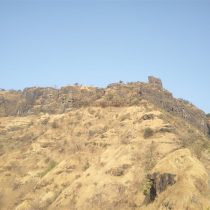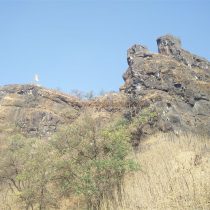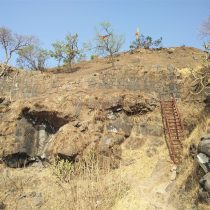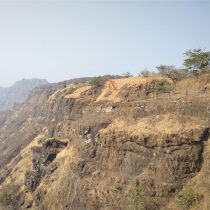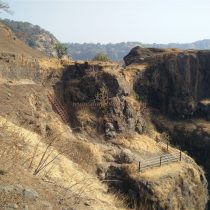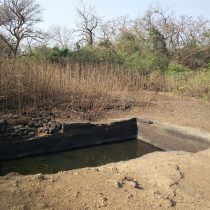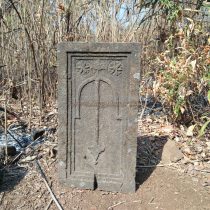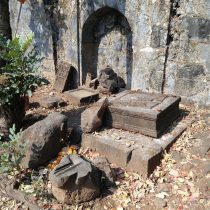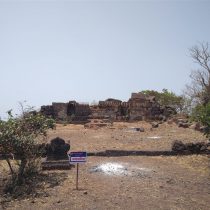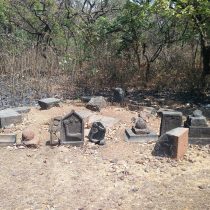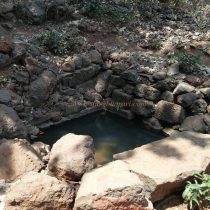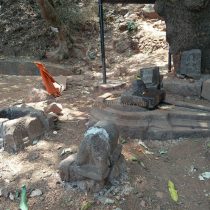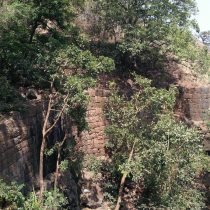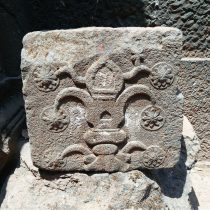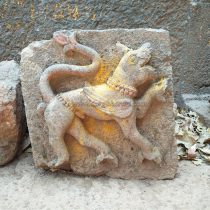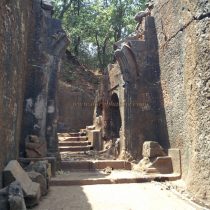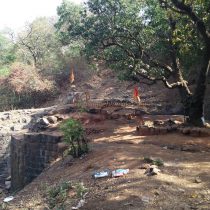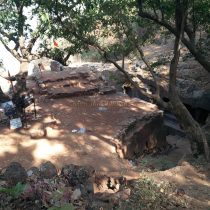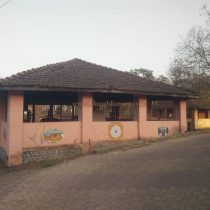MAHULI
TYPE : HILL FORT
DISTRICT : THANE
HEIGHT : 2615 FEET
GRADE : MEDIUM
Mahuli Fort is a famous place for a day trip in Shahapur taluka near Mumbai-Thane. This fort is situated in the mountains of Sahyadri. There is not just one fort here, but a group of three forts. These three forts are separated from each other by a ravine, with Mahuli at the center, Palasgad at the north, and Bhandargad at the south. All these forts have separate gates and different ways to go up. The Mahuli Fort in the middle is the largest and has access to Bhandargad and Palasgad. If you plan your time well, you can stay at the base of the fort the day before and start early in the morning the next day. You can visit all three forts in one day and return in the evening. As Mahuli, Bhandargad, and Palasgad are three separate forts, they are not described together.
...
To reach Mahuli fort from Mumbai-Thane, one has to reach Mahuli village at the foot of the fort from Asangaon on the Thane-Nashik highway. The distance from Mumbai is 77 km and from Thane, it is 55 km. Tourist accommodation is built for tourists to stay here and there is also a facility to stay in the Ganapati and Mahadev temples in the village. There are three old temples in the settlement at the foot of the fort, one of which belongs to Lord Ganesha, the other to Lord Shiva, and the third to the village deity. There are some sculptures scattered in the temple premises and a medieval lake can be seen in the village. After visiting the Shiv temple, a road goes to the right at the back of the temple. There is a Ganesha temple a few minutes away on this road and drinking water is available at the hand pump in front of the temple. In the courtyard of Ganesha temple, one can see a stone dome and a partially broken hero stone. Crossing the newly constructed arch along this path, we reach the newly constructed tourist center by the forest department. To reach the fort, one has to pay an entrance fee of Rs. 20 per person. The fort is crowded with tourists and the path that goes to the fort from here is visible with sparse forest. This path is pretty steep. After crossing the hill and stream in front of the tourist center, we reach a plain surface. Remains of some structures can be seen in this place. During the Peshwa period, at the foot of the Mahuli fort, there are mentions of Chief’s offices and palaces. In this way, by doing easy rock climbing in 2-3 places, in about two hours we come to the bottom of Mahuli fort. The ramparts of the fort in this part still exist and an iron ladder about 15-20 feet high has been installed to climb the ramparts and the ridge. After climbing this ladder and crossing the ramparts, you enter the Mahuli fort. To reach the fort, there are different routes like Mahadarwaja, Hanuman Darwaza, Kalyan Darwaza, vandre Pass, Palasgad, and Mahuli Pass. The ladder route we came from Mahuli village is not the original route to the fort, at present, it is the shortest and easiest way to reach the fort. After crossing the ramparts, a straight path leads you to the main gate of Mahuli fort. In this way, you can see a water cistern carved in the rock. The water in this cistern is not drinkable. After walking for 5 minutes on this road, the fork leading to Bhandargad is spotted on the left, and on reaching it, another fork on the right could be seen. The straight path from here leads to a Mosque known as Namazgir on Mahuli fort, while the path on the right goes down to the main gate of Mahuli fort. The main gate of Mahuli fort is carved in the rock and it is protected by bastions on both sides. The arch on the door has collapsed. The guards' porches are also carved in the rock and except for the rainy season, it can accommodate 10-12 people. The road leading from the Machi village to this gate has been destroyed over time. Outside the door, there is two carved stone and on one of the stones, there are carvings of lotuses. There is a drinking water cistern in front of the gate and it is the only source of drinking water at Mahuli fort and Palasgad. There are some inscriptions kept under the mango tree and there is also a buried Tulsi Vrindavan nearby. Shivaji Maharaj’s followers have installed an idol of Maharaj on the bastion next to the door. On the right side of the main gate, towards the north, there is a path leading to Palasgad in Karvi. After walking for 10 minutes on this road, you can see a structure on the right side of the road. This structure is said to be the mansion of the fort. After coming from here, the fork on the right side of the road can be seen. The straight path from here leads to the northern end of Mahuli fort. At this point, no other remains are visible except the sparse remains of the outpost. From here, the path descending to the right leads to Palasgad. This road crosses the ramparts of Mahuligad and descends into the valley between Mahuligad and Palasgad. The fortified gate of Mahuli fort has completely collapsed today and only the quadrangle structure and some fortifications remain. The road coming from Khor, west of Palasgad, meets this road while descending into the valley. After seeing this part of Mahuli fort, come back to Mahadarwaja. Now that you want to tour the entire Mahuli fort, take enough water from the cistern here and start your fort round. From here, take the road to Bhandargad that you saw at the beginning. When you go straight on this path, at some distance, you can see three stones of broken Samadhi. After visiting the Samadhi, on the left side of the road, you can see a large quadrangle structure built of stone, six feet high, with steps leading into the Karvi forest. Today, this quadrangle structure is the only remains of the mansion. Around this quadrangle structure, many remains of buildings are hidden in the Karvi forest. Looking at the quadrangle structure, you can see many relics in the trees along the way. Next, you can see a rectangular carved rock erected on the road, but it is not clear what this rock should be about. Next to this rock is the Shiv temple. The three-sided walls of this temple, which is on a quadrangle structure, are still standing today. The temple has a carved Shivling as well as a hero stone and some broken inscriptions. In front of the temple is a large pool of dried water. As you approach the lake, you will see a carved stone placed on the tomb on the way. From here, the road leads to the peak. As you ascend this hill, you see a straight path with an unclear path on the right. Within 500 feet on this path, you will see the remains of a large mansion on the right. At a short distance from this mansion, there is a barn with walls on all four sides, and pieces of earthen pots can be seen in this barn. When you return to the main road after seeing the barn, you will see a fork to the left on the straight path. This path leads to Hanuman Darwaza at the east end of Mahuli. At the end of this path, which descends towards the ridge, only the remains of Hanuman Darwaza can be seen. The fort has a sloping rampart and two iron ladders are attached to the lower part of the gate. Sculptures of Ganapati and Hanuman are carved on the wall of this road. This road leads to Mahuli village but no one except the locals use this road so the path is not that clear. The pinnacle of Bhatoba, Navara, and Navri standing in front is seen from here and the pinnacle of Wazir is seen on the right side. After seeing the Hanuman Darwaza and returning to the original path, the straight path leads through the Jamun forest to the gorge at Bhandargad at the southern end of the fort. From this point, there is a beautiful view of the fortifications of Bhandargad, the steps carved in stone to go up to it, and the gorge. This gorge is known as vandre khind. After seeing the gorge, without turning back take up the path near the ridge in the west. After crossing the west side of the fort for about 20 minutes, we come to a partially demolished structure. This structure is the Namazgir building above the Mahadarwaja. Standing on a quadrangle structure, the building has only the west side wall and has two large arches. There is a Persian inscription near this building and the stones of the buildings are scattered around. If you go straight on the path to the right of the Namazgir, you will find the remains of a mansion, while near the tree in front you will see a large number of Satishila and Samadhi. Descending from this tree towards Mahadarwaja, one can see carvings and Tulsi Vrindavan. When you reach the main gate, your fort round is complete. The Shivdurg Pratishthan is currently carrying out conservation work on the fort and they have cleared out the bushes around Mahuleshwar Temple and Hanuman Darwaza. Their work is much appreciated. Alang, Madan, Kulang, and Kalsubai ranges are visible to the north, Tungareshwar and Gumtara forts to the west, Harishchandragad, Ajoba, and Matheran ranges to the south and other regions. It takes three hours to reach the fort from the base and two hours to explore the entire fort. Since Mahuli was an important fort in medieval times, it read that many battles took place around the fort to capture it. Although it is not known who built the fort, it came under the control of Malik Ahmed, the founder of the Nizamshahi, around 1485, after the fall of the Bahamani kingdom. In the medieval period, this fort near Kalyan county was connected with important places like Nashik, Surat, Junnar, and Ahmednagar. Mahuli gained importance due to its geographical structure. When the combined forces of Mughals and Adilshahis came to overthrow the Nizamshahi, around 1635-36, Shahaji Raje took refuge in the fort of Mahuli to save the Nizamshahi. Khanjaman besieged Mahuli. Shahaji Raja asked the Portuguese for help but they refused and Shahaji Raja surrendered. Later on January 8, 1658, Shivaji Raja captured this fort from the Mughals. While giving 23 forts to the Mughals in the Purandar treaty of 1665, Shivaji Maharaj cleverly gave these combined forts to the Mughals as three forts. After that, Manohardas Gaud, the Mughal chieftain, began to rule over Mahuli fort. He did a lot of construction on the fort. In February 1670, Shivaji Raja himself attacked Mahuli to conquer the fort. Because of awareness of fort keeper Manohardas Gaud, out of one and a half thousand Mavals, about one thousand Mavalas were cut down by the Mughals and the Marathas had to be defeated. Still, Manohardas Gaud left the fort of Mahuli out of fear of the Marathas and was replaced by a new fort chief Alavardi Beg. After that, on 16th June 1670, after a siege of two months, Moropant Pingale annexed the trio forts of Mahuli, Palasgad, and Bhandargad. After the death of Sambhaji Maharaj, the fort keeper dwarkoji betrayed the Marathas and handed down the fort to the Mughals. As it was difficult to attack the fort and capture it, the Marathas made the people on the fort quarrel among themselves and bribed them, and took control of the fort in 1735. Later, Bajirao II handed over the Mahuli fort to the British as per the treaty in June 1817.
© Suresh Nimbalkar

